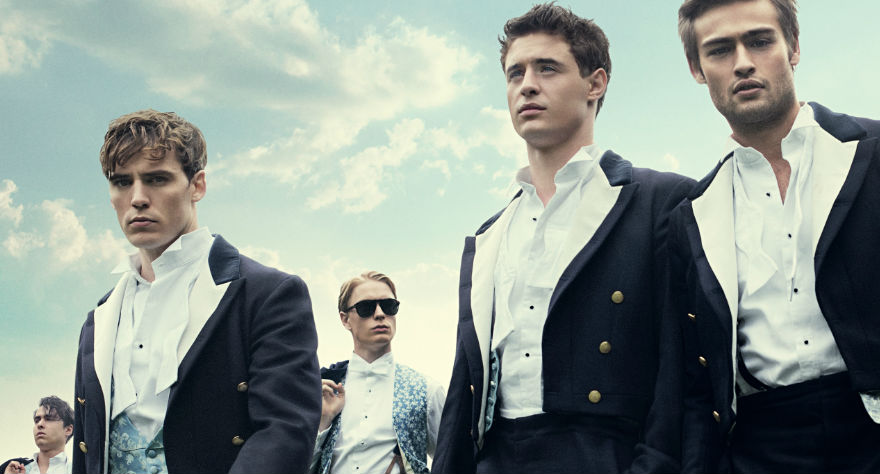
The rich and mighty elite of Oxford take spoiled to new heights of rotten in this class-clashing thriller.

The rich and mighty elite of Oxford take spoiled to new heights of rotten in this class-clashing thriller.
“With the rich and mighty, always a little patience.”
That line – perhaps the greatest in a film full of great lines – can be heard in George Cukor’s The Philadelphia Story (1940), the crackling romantic comedy from Hollywood’s Golden Age. It refers to the patience needed by those dealing with the rich and mighty in matters pertaining to the common man, for the rich and mighty simply don’t understand those matters and need more time than most to figure them out. In The Riot Club, the subjects of the drama are rich and mighty, and they require patience from others when it comes to matters pertaining to the common man. Unlike the Golden Age classic, though, this film also requires patience from the viewer…patience at a level most viewers don’t have.
Alistair Ryle and Miles Richards (Sam Claflin and Max Irons, respectively) are freshman at Oxford University. Wealthy, smart, and ridiculously handsome, the young men who have it all are offered one more thing: membership in the Riot Club. Made up of male students with as much intellect, wealth, and looks as the two freshman, the Riot Club is so exclusive its ranks never rise above 10 in a given school year, and its debaucherous exploits are the stuff of legend. So elite are the club’s members that they routinely go on to become captains of industry and titans of politics.
Membership has more than its privileges, though; it also has its complications. Miles’ classmate and new love interest, Lauren (Holliday Grainger), is uncomfortable with some of the club’s initiation rituals, and more than a few people are troubled when the club’s annual dinner grows increasingly out of hand.
It’s ironic that The Riot Club, from director Lone Scherfig and screenwriter Laura Wade (who adapted her own stage play, “Posh,” for this script), is a film about excess, because the film itself is a victim of its own excessive attempts to be too many things. Ultimately it fails to succeed at being any of them, although remnants of things litter the film throughout.
After the filmmakers offer a quick origin tale of the fictitious club (in bawdy style), Act One has too much work to do: It must introduce and provide at least a little background on Miles, Lauren, and Alistair, as well as the eight current members of the Club; it must illustrate the affluence and recklessness of the Club members; it must establish and build the relationship between Miles and Lauren; it must create a rivalry between Alistair and Miles; it must set up for the gay Club member to show a romantic interest in Miles; and it must illustrate just how bonkers the Club’s initiation process is. That’s a lot to deliver, and other than how deftly the Miles/Lauren romance is established, everything else that happens, and everyone else onscreen, are flat sketches.
Where Act One is jam-packed, Act Two is bloated. As part of the new member welcoming process, the club goes out to dinner, and by “goes out to dinner” I mean engages in a bacchanal. This sequence is endless and, at points, rather vile. What is supposed to be some great commentary on class difference is really nothing more than rich boys behaving badly interrupted by occasional proselytizing. The celebration that starts as crazy devolves into a nightmare for the pub owner and eventually for the Club itself. It’s difficult to elaborate without spoilers, but it’s important to note that Act Two suggests key moments in Act One were designed solely to serve as plot-points for later in the story.
Act Three is accelerated, predictable, and wholly unsatisfying.
Despite its overall tenor, The Riot Club has its moments. Irons has a natural charm the camera picks up on immediately, even in smaller moments; the same can be said of Grainger. Together, they have undeniable onscreen chemistry that another filmmaker ought to showcase with material a little more suitable for romance. Also worth checking out is Sebastian Blenkov’s luxurious cinematography; he knows how to soften scenes to complement well the onscreen affluent lifestyle. In addition, some of the dialogue is wickedly funny.
A gorgeously shot film featuring a cast with cheekbones for days can only go so far on looks alone. Eventually it needs to back up its image with some substance, but the filmmakers get too caught up in portraying the Lifestyles of the Rich and Felonious and neglect critical storytelling and character development elements that leave the finished product as pretty and empty as the people it portrays.